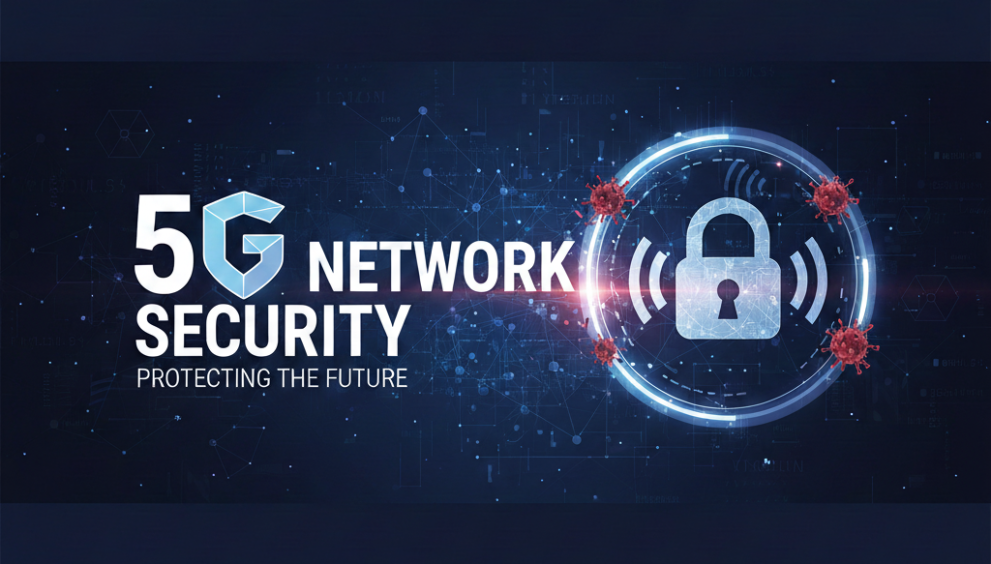Ultra-fast mobile coverage is moving across India. Cities see dense rollouts, smaller towns follow, and a growing web of connected devices now sits in homes, clinics, factories, and offices. Speed and capacity are welcome, yet they change the security picture. The tools and habits that worked in the 4G era may not be enough in the new environment.
In this article, you will explore the meaning of 5G network security, how it differs from previous generations, the main risks to watch, India’s policy direction, and simple steps that help people and organisations stay safe.
What is 5G Network Security and Why it Matters
5G network security is the collection of controls and practices that protect 5G infrastructure and everything that connects to it. In the context of home and hybrid setups, the importance of cybersecurity for remote workers becomes clear. Protection spans radio access, the transport layer, the core, edge sites, cloud workloads, and the vast number of consumer and industrial devices that depend on these networks.
How 5G differs from 4G, in plain terms:
- Cloud native design: Many network functions run as software components in data centres. This speeds up innovation but creates more moving parts that need patching, access control, and monitoring.
- Edge computing: Processing moves closer to the user to cut the delay for sensitive work such as telemedicine or automation. More edge locations mean more points to secure.
- Massive device density: One cell can support far more devices than before, including small sensors and wearables. Each weak device can be a doorway.
- Network slicing: Operators can create logical slices for a use case such as emergency services or smart factories. Slices must be isolated to avoid spillover if one area is compromised.
For India’s digital economy, which now stretches from village kiosks to global fintech, a resilient approach to 5G network security, guided by total security principles, underpins trust, continuity and compliance.
The Link Between 5G and Cybersecurity
The meeting point of 5G and cybersecurity is hard to ignore. Low latency and high throughput enable services that rely on instant responses. Payments, smart grids, and remote care all benefit, yet the same properties also help attackers scan faster, move more quickly, and hide amid a much larger volume of traffic. Defenders need continuous visibility, identity-centred controls, and rapid response across cloud, edge, and device layers.
Top 5G Cybersecurity Risks and Threats
New features introduce fresh 5G cybersecurity threats. The list below captures the five most common 5G cybersecurity risks in modern deployments.
1. IoT Device Hacking
Many low-cost devices still ship with weak defaults. Attackers seek unused passwords, outdated software and ports. After a device is compromised, it could be used to spy on, to become a member of a botnet or to make progress to more valuable systems. Simple steps can help: update credentials, use updates, limit which devices can communicate, and keep smart devices on a separate network.
2. DDoS Attacks
Distributed denial of service attempts to exhaust capacity or overwhelm an application. The reach of 5G means botnets can produce very large floods or ramp up sudden bursts. Protection improves when several layers work together: rate limiting at the edge, carrier scrubbing, and smart filtering closer to the application. On the user side, follow simple practices like protect your phone on public WiFi.
3. Data Interception
Poorly secured apps or misconfigured radios can expose information. Criminals may set up rogue access points in busy areas, impersonate trusted names, and intercept traffic. End-to-end encryption, certificate pinning where suitable, and careful network selection reduce exposure. People should avoid sensitive tasks on open networks when possible.
4. Network Slicing Vulnerabilities
Slicing lets an operator dedicate resources to a service, but weak isolation can allow data to move between slices. Strong identity for users and machines, strict role-based access to orchestration tools, and regular validation of slice policies are central to safe operation.
How India is Strengthening Its 5G Network Security Framework
India’s regulatory and policy work has added several layers of support for safer networks.
- National guidance on trusted equipment: The National Security Directive on the Telecommunication Sector introduced the Trusted Telecom framework, which guides the use of approved products and sources in new network additions. The aim is to reduce supply chain risk and improve assurance.
- CERT-In directions for incident handling: Designated entities are required to report specific incidents within a short window and retain logs for analysis. Time synchronisation across systems is encouraged so that investigations are accurate and timely.
- TRAI consultations and technical studies: Reviews have explored how features such as network slicing fit within the existing policy space, with an eye on quality of service, fair access, and user safety.
- Public-private collaboration: Operators, equipment makers, security vendors, and government bodies now run more joint drills and share indicators more frequently. This culture of cooperation becomes crucial as 5G connects critical services.
These efforts sit alongside Digital India goals that promote resilient infrastructure, citizen services, and wider access to secure connectivity.
How 5G Impacts Businesses and Everyday Users
The benefits are clear, but risk management changes with them.
- Finance and retail: Richer apps, instant payments, and biometric checks rely on stable networks. Organisations tighten API security, monitor for unusual transaction patterns, and harden devices used by field staff.
- Healthcare: Remote monitoring, connected ambulances, and cross-site imaging need confidentiality and low delay. Hospitals build strict network segments, maintain clinical device inventories, and set clear patch windows that respect uptime requirements.
- Manufacturing and logistics: Private 5G or dedicated slices connect robots, cameras, and sensors across plants and warehouses. Teams align operational and IT security, enforce allow lists, and monitor for changes in traffic behaviour.
- Remote and hybrid work: Home routers and personal devices can be weak links. Awareness training matters, as do simple steps for staff who work from home.
For everyday users, 5G improves streaming, calls, and cloud apps. The basics remain vital: software updates, careful permissions, and wise choices on public networks.
How to Stay Safe: Practical Tips for 5G Users
Treat the following as a practical checklist for daily life and work:
- Change all the things: Maintain phones, laptops, routers and smart devices. Enable automatic updates whenever possible and verify the firmware on routers and cameras.
- Install reliable security software: Endpoint protection identifies known threats, blocks suspicious web addresses, and helps secure online payments.
- Secure Wi-Fi at home and the workplace: Change default passwords, use WPA3 where possible, and maintain a separate guest network for visitors and smart devices. Remote management should be disabled unless necessary.
- Protect IoT at the point of purchase: Purchase brands that update their policies, switch factory credentials, and switch off idle functionality. Install cameras, sensors, and smart speakers on another network, rather than laptops.
- Watch yourself on open Wi-Fi: Do not use open Wi-Fi to bank or do any other important activities. You have to use a reliable VPN when you need to be connected in open places.
- Install multi-factor authentication: Authenticator apps are more secure than text-sent codes. Begin with email, bank and office accounts.
- Limit permissions: Check phone and tablet app permissions. Uninstall unnecessary applications and delete those you no longer use.
- Store valuable information: Have more than one copy of photographs and papers. Periodic backups will mitigate the effects of the ransomware or the loss of the device.
- Be aware of compromises: Sluggish computers, weird pop-ups and changing settings should be noticed. In case of uncertainty, disconnect from the network and consult.
These habits reduce risk without adding friction to your day.
The Future of 5G Cybersecurity in India
Protection will keep evolving as adoption grows:
- AI-assisted defence: Telecom analytics can sift through large volumes of telemetry to spot anomalies faster. This shortens the time from detection to containment.
- Zero trust principles at scale: Identity sits at the centre. Verification happens for every user, device, and workload, whether inside or outside the traditional perimeter.
- Safer device ecosystems: Clearer update policies and better defaults for consumer IoT will likely become the norm as awareness grows.
- Skills and collaboration: Training for engineers and security teams, combined with cross-sector exercises and shared indicators, will raise the bar for attackers.
The goal is resilience. Perfect safety is unrealistic, yet steady improvement in design, operations, and awareness keeps incidents smaller and rarer.
frequently asked questions
-
What is 5G Network Security?
It is the set of technologies and routines that protect 5G infrastructure and connected devices. The scope covers radio access, core and transport layers, edge sites, cloud components, and end-user equipment.
-
How can individuals protect themselves on 5G networks?
Keep software up to date, use strong, unique passwords with multi-factor authentication, install reputable security tools, and avoid sensitive tasks on open Wi-Fi. The public Wi-Fi guide listed above offers a simple checklist.
-
What are the security solutions of 5G networks?
Common solutions include endpoint protection, carrier-grade DDoS mitigation, network detection and response, device-to-service encryption, identity and access management, and strict controls for slice orchestration.
-
What is a major security concern in 5G networks?
Weak or poorly configured connected devices are a frequent concern, as they can be used to gain access to a network and move towards more valuable systems.
-
How is India strengthening 5G cybersecurity?
Measures include guidance on trusted telecom products, incident reporting and log retention directions, ongoing consultations on new features, and closer collaboration between industry and government.



